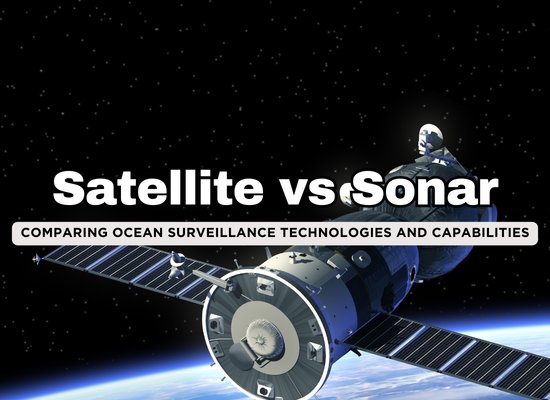Satellite vs. Sonar: The Battle for Maritime Monitoring Supremacy

Oceans cover more than 70% of the planet, yet they remain one of the least monitored environments. Tracking vessel activity, mapping the seafloor, and detecting underwater threats require advanced technology, and two primary methods—satellites and sonar—are at the center of this battle for supremacy. While satellites offer a broad view from above, sonar provides deep insights from below.
Each method has advantages and limitations, and the effectiveness of maritime surveillance depends on the situation, location, and objective. Let’s explore five key issues in ocean monitoring and see how satellites and sonar compare in tackling them.

1️⃣ Surface Vessel Tracking
One of the biggest challenges in maritime security is identifying and tracking vessels across vast ocean regions. Governments, shipping companies, and law enforcement agencies need to monitor cargo ships, fishing vessels, and military fleets to prevent smuggling, illegal fishing, and unauthorized incursions.
How Satellites Perform
- Satellites provide global coverage, making them ideal for tracking ship movements over open waters.
- Synthetic Aperture Radar (SAR) can detect ships even at night or through clouds, unlike traditional optical imaging.
- Automatic Identification System (AIS) data, transmitted by legally registered vessels, is collected by satellite receivers, allowing for real-time monitoring.
- However, satellites struggle to track vessels that turn off AIS transponders or use tactics like GPS spoofing.
How Sonar Performs
- Sonar excels at detecting underwater vessels, such as submarines, but is limited in surface vessel tracking.
- Passive sonar can sometimes detect engine noises and propeller signatures from ships, but it requires close-range deployment.
- Coastal sonar stations or underwater networks can identify ships moving in restricted zones but cannot provide wide-area tracking like satellites.
Verdict
For tracking large-scale surface vessel activity, satellites have the clear advantage. They provide broad, real-time coverage and can track ships over thousands of miles. However, sonar plays a niche role in detecting specific vessel movements in controlled maritime zones.
2️⃣ Detecting Submerged Objects and Submarines
One of the greatest challenges in maritime surveillance is tracking submerged objects, including submarines, sunken vessels, and underwater drones. Military forces, research institutions, and commercial industries all have a vested interest in monitoring what lies beneath the surface.
How Satellites Perform
- Satellites primarily rely on optical and radar imaging, which are ineffective for detecting submerged objects due to water opacity.
- Some advanced satellites use infrared imaging to detect temperature variations on the surface, which can sometimes indicate the presence of submarines due to heat emissions.
- Satellite-based gravitational anomaly detection is an emerging method that can map large underwater features, but it lacks the precision needed for real-time submarine tracking.
- Ultimately, satellites are limited when it comes to anything below the surface, making them ineffective for real-time underwater surveillance.
How Sonar Performs
- Sonar is the gold standard for detecting submerged objects. It uses sound waves that travel through water to map the seafloor, detect underwater structures, and track moving submarines.
- Active sonar sends out pulses and analyzes the returning echoes to pinpoint objects underwater, making it the primary tool for anti-submarine warfare.
- Passive sonar listens for acoustic signatures, such as engine noise or propeller movement, making it useful for stealth detection.
- Sonar networks, such as SOSUS (Sound Surveillance System), have been deployed in key ocean regions for decades to monitor submarine activity.
Verdict
For submerged object detection, sonar is far superior. Satellites simply do not have the capability to penetrate deep water, while sonar provides precise tracking of submarines, wreckage, and other underwater anomalies. However, sonar is limited in coverage, requiring extensive networks to monitor large ocean areas effectively.
3️⃣ Mapping the Ocean Floor
The ocean floor remains one of the least explored frontiers on Earth. Accurate seafloor mapping is crucial for navigation, undersea cable placement, natural resource exploration, and scientific research. The challenge lies in mapping vast underwater areas with precision and efficiency.
How Satellites Perform
- Satellites can provide broad-scale mapping of the ocean floor using altimetry, a technique that measures sea surface height variations caused by underwater features.
- Satellite gravimetry helps identify large underwater structures such as mountain ranges, ridges, and trenches by detecting gravitational changes in the ocean surface.
- While satellites offer a global view, their depth resolution is limited—typically around 1 to 2 kilometers, meaning they can detect major seafloor features but not finer details.
- They are useful for preliminary ocean mapping, but they lack the ability to capture precise, high-resolution topography.
How Sonar Performs
- Sonar, specifically multibeam echo sounders, is the most accurate tool for detailed seafloor mapping.
- Active sonar sends sound waves that bounce off the ocean floor, providing precise depth measurements and three-dimensional topography.
- Sonar surveys can map features down to a resolution of just a few meters, making them essential for deep-sea exploration, pipeline routing, and underwater navigation.
- The biggest drawback is coverage speed—sonar mapping is slow and expensive, requiring ships to traverse the ocean in a grid-like pattern to create detailed maps.
Verdict
For large-scale ocean floor mapping, satellites provide a useful starting point, offering a general overview of major undersea features. However, for high-resolution, detailed mapping, sonar is the clear winner. The two technologies often work together, with satellites identifying areas of interest and sonar conducting detailed surveys.
4️⃣ Monitoring Illegal Activities at Sea
Illegal fishing, smuggling, human trafficking, and unauthorized vessel movements pose major threats to maritime security. Effective ocean surveillance must be able to detect and track illicit activities across vast and often unregulated waters.
How Satellites Perform
- Satellites excel at wide-area surveillance, making them a powerful tool for detecting illegal activities in remote ocean regions.
- Synthetic Aperture Radar (SAR) can detect vessels even at night or through cloud cover, providing critical intelligence on unauthorized movements.
- Satellites can track AIS (Automatic Identification System) signals, but many illegal vessels turn off their transponders to avoid detection.
- Some satellite systems use radio frequency (RF) monitoring to detect signals from boats that are attempting to operate covertly.
- While effective for identifying suspicious vessel behavior, satellites cannot confirm cargo contents or detect submerged smuggling routes.
How Sonar Performs
- Sonar is valuable for detecting illegal underwater activities, such as submarine smuggling or vessels attempting to evade radar by operating at low depths.
- Passive sonar arrays deployed in key maritime zones can listen for engine noises from illegal submarines or drug-running submersibles.
- Sonar systems placed near territorial waters help detect ships that disable their tracking systems and attempt to move undetected.
- However, sonar’s coverage is localized, making it ineffective for monitoring large open-sea areas compared to satellite-based tracking.
Verdict
For surface-level illegal activities, satellites are the dominant surveillance tool, offering broad coverage and high-resolution imagery to track unauthorized vessels. However, for covert underwater operations, sonar plays a critical role in detecting hidden movements that satellites cannot see. The best maritime security strategies often integrate both technologies to track illicit activities from multiple angles.
5️⃣ Tracking Environmental Changes and Marine Ecosystems
Oceans play a crucial role in regulating the Earth’s climate, supporting marine biodiversity, and sustaining global fisheries. Monitoring environmental changes such as rising sea levels, coral reef degradation, ocean acidification, and pollution requires advanced surveillance technologies.
How Satellites Perform
- Satellites are highly effective for large-scale environmental monitoring, providing real-time data on sea surface temperatures, ocean currents, and rising sea levels.
- Optical and infrared imaging can detect harmful algal blooms, oil spills, and plastic pollution spread across the ocean surface.
- Satellite altimetry helps measure changes in sea level and ice melt, offering crucial insights into climate change impacts.
- While satellites provide an excellent big-picture view, they struggle to capture detailed underwater environmental changes, such as deep-sea habitat degradation or localized coral bleaching.
How Sonar Performs
- Sonar is crucial for underwater environmental monitoring, detecting changes in seabed conditions, marine biodiversity shifts, and deep-sea mining impacts.
- Acoustic monitoring systems help track marine mammal populations and detect noise pollution from shipping and industrial activities.
- Sonar is used to study coral reef health and underwater ecosystem changes that satellites cannot see.
- However, sonar’s coverage is limited to specific survey areas, making it less effective for continuous, large-scale ocean monitoring compared to satellites.
Verdict
For ocean-wide climate monitoring and pollution tracking, satellites are the superior tool, offering continuous real-time data on a global scale. For detailed ecosystem analysis and underwater environmental changes, sonar is the better choice, providing insights into areas that satellites cannot reach. The two technologies complement each other in studying ocean health and detecting long-term environmental trends.
The Future of Maritime Surveillance
Satellites and sonar each have unique strengths, and neither can fully replace the other in ocean monitoring. Satellites dominate surface-level tracking, global surveillance, and climate monitoring, while sonar remains unmatched in underwater detection, submarine tracking, and detailed seafloor mapping.
As technology advances, the future of maritime surveillance will likely involve the integration of both systems, supported by artificial intelligence, autonomous underwater drones, and machine learning algorithms to enhance real-time ocean monitoring. The combination of satellite-based global oversight with sonar’s precision capabilities will create a more comprehensive approach to managing ocean security, environmental conservation, and maritime operations.
The battle for maritime monitoring supremacy isn’t about choosing between satellite and sonar—it’s about leveraging both to fully understand and protect the world’s oceans.
Table Summary
| OceanSurveillance: Satellite vs. Sonar – The Battle for Maritime Monitoring Supremacy | ||||
| Issue | Satellites | Sonar | Best Use | Limitations |
| Surface Vessel Tracking | Covers vast ocean areas, detects ship movements, and uses AIS tracking. Great for spotting illegal fishing and smuggling. | Limited to detecting engine noise and propeller movement in coastal zones. Not practical for open ocean vessel tracking. | Satellites win for tracking ships across large distances. | Ships can turn off AIS transponders to avoid satellite detection. |
| Detecting Submerged Objects | Struggles to detect anything below the ocean’s surface. Some infrared tech can identify heat disturbances, but not reliably. | The go-to tool for finding submarines and sunken vessels. Uses active and passive sonar to detect underwater threats. | Sonar is the only reliable option for tracking objects underwater. | Coverage is limited to areas where sonar is deployed. |
| Mapping the Ocean Floor | Uses satellite altimetry and gravity mapping to get a general picture of seafloor structures. Good for large-scale mapping. | Multibeam sonar gives high-resolution maps with precise topography. Used for deep-sea exploration and undersea construction. | Satellites for big-picture mapping, sonar for detailed work. | Sonar is slow and expensive, satellites lack fine detail. |
| Monitoring Illegal Activities | Great for spotting large-scale smuggling operations, illegal fishing, and ship movements. AIS data helps track vessels in real time. | Best for detecting hidden submersibles, covert underwater smuggling, and unauthorized movements near coastal zones. | Satellites for large-scale surface monitoring, sonar for stealth detection. | Satellites struggle if bad actors turn off AIS, sonar has limited range. |
| Tracking Environmental Changes | Monitors ocean temperature, sea level rise, and pollution spread. Great for large-scale climate and weather data. | Tracks marine ecosystems, coral reef health, and underwater noise pollution. Provides fine-detail analysis. | Satellites for ocean-wide monitoring, sonar for ecosystem studies. | Satellites can’t analyze deep-sea ecosystems, sonar has limited range. |



